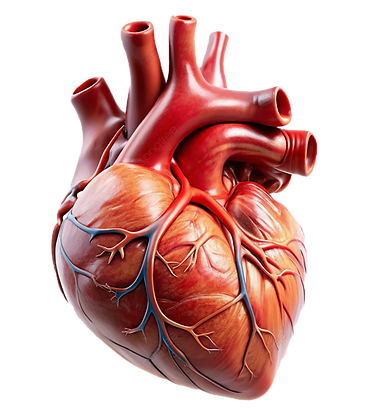.png)

Lupus & Heart Disease
The human heart is the strongest muscle in the body but is only the size of a fist. The heart pumps blood through the body with every heartbeat. The cardiovascular system is very vulnerable to breakdown due to a variety of risk factors, many of which can lead to heart disease.
WHAT IS HEART DISEASE?
The terms coronary artery disease, cardiovascular disease or coronary heart disease is generally referred to as heart disease. Cardiovascular disease is one of the leading health concerns and the number one cause of death in America. This condition can lead to heart attack or myocardial infraction when enough plaque grows to reduce or completely block the blood flow through the coronary arteries- the arteries that supply blood to the heart.

The blocked artery prevents oxygen and nutrients from getting to the heart. Arteriosclerosis is responsible for many deaths resulting from heart attacks.
There are several diseases of the heart and blood vessel system to include cerebrovascular, ischemic, peripheral vascular, hypertension (high blood pressure), rheumatic heart disease and others. Becoming familiar with the anatomy of the heart will provide a better understanding of how the heart functions and its diseases.
Cerebrovascular Disease (Stroke)
When the heart isn’t working effectively, blood clots are more likely to form in the blood vessels of the brain. Sometimes, with blood clots or stroke, a blood vessel can burst in some part of the brain and neck. If treatment is received quickly enough, too many brain cells may die in vital areas of the brain causing problems with speech or vision, weakness or even paralysis. If a person survives a stroke, essential brain function may never return or may take time and rehabilitation to recover.
Ischemic Heart Disease
Ischemic heart disease (Coronary artery disease) is the most common type of cardiovascular disease. It is caused by problems with the circulation of blood to the heart. Ant blockage to one or more of the coronary arteries can result in insufficient oxygenated blood. Complete blockage of an artery causes damage to tissues, a heart attack, and heart failure.
Symptoms of Coronary artery disease include:
-
Dyspnea (shortness of breath)
-
Angina (chest pain)
-
Irregular heart beats
-
Weakness or dizziness
-
Sweating
-
Nausea
Heart attack
A heart attack (myocardial infarction) occurs when the coronary arteries narrow so much that they stop blood supply to the heart. This is the result of damaged to the heart muscle or cholesterol buildup in the arteries called atherosclerosis. A piece of the cholesterol breaks off and can block the blood vessel. The heart cells begin to die as they’re deprived of oxygen.
Symptoms of a heart attack can include:
• Pressure or heaviness in chest
• Rapid heartbeat
• Anxiety, weakness, shortness of breath
• Pain that radiates to the back, jaw, or left arm
• Swelling of the legs
• Fullness, indigestion (feeling similar to heartburn)
-
Sweating, nausea, vomiting
Pulmonary Embolism
A pulmonary embolism is similar to a stroke; however, the blocked blood vessel is formed in the lungs instead of the brain.
Symptoms of pulmonary embolism include:
• Shortness of breath
• Chest pain when breathing
• Cyanosis (appearance of a bluish tint to the skin) because the body is quickly deprived of oxygen
A pulmonary embolism can be fatal and is considered an emergency.

Rheumatic Heart Disease
Rheumatic heart disease is caused by attacks of rheumatic fever, which then does damage to the heart. It usually occurs with a bacterial infection (streptococcal infection) in childhood. The infection affects the heart causing weakened heart muscles, a damaged sac that encloses the heart, and scarring heart valves so they don’t open and close properly.
Peripheral Artery Disease (PAD)
Peripheral artery disease (PAD) affects the circulation in the arms and legs due to narrowing in the arteries that supply blood to those areas of the body. Primary symptom of PAD is claudication (severe leg pain when walking).
Congenial Heart Disease
Congenial heart disease is a birth defect that occurs when the heart’s muscles become too damaged to properly pump the blood throughout the body. These defects can be a hole inside the walls of the heart or they can affect blood flows through the heart and lungs.
Congenital heart disease symptoms are similar to heart failure, if present in adults.
Symptoms of congenital heart disease in infants and children can include:
• Shortness of breath during feedings
• Inadequate weight gain
• Lack of ability to exercise
• Pale gray or bluish skin color, fingernails, and lips
• Lung infections
YOUR LIFESTYLE, YOUR AGE, AND FAMILY HISTORY ALL PLAY A ROLE IN YOUR RISK OF HEART DISEASE.
Some of the factors are out of your control. But you can take action to lower your risk and control any other risk you may have.
Risk Factors for Developing Cardiovascular Disease
• Age
As you age, your risk of damaged and narrowed arteries and weakened heart muscle are increases.
• Sex
Men have a greater risk of developing heart disease than women.
• Heredity
Those who have a family history of heart disease have an increases risk of coronary artery disease, especially if a parent developed it at an early age.
• Smoking
Heart attacks are more common in smokers because nicotine constricts blood vessels, and carbon monoxide damages the inner lining of the heart.
• Poor diet
An increase amount of salt, sugar, fat and cholesterol in your diet can contribute to the progression of heart disease.
• High blood pressure
Uncontrolled high blood pressure can cause hardening and thickening of the arteries, limiting blood flow through the vessels.
• High blood cholesterol levels
As blood cholesterol in your blood increases, so does the risk of formation of plaques and atherosclerosis.
• Obesity
Having too much body fat produces inflammation and raises you chances of medical conditions such as heart disease.
• Physical inactivity
Lack of exercise contributes to many forms of heart disease.
• Stress
Uncontrolled stress can damage your arteries and increase the risk factors for heart disease.
• Poor hygiene
Washing your hands regularly and establishing other good habits can help prevent viral or bacterial infections which can put you at a lower risk of developing heart infections. Lack of good dental health may also contribute to heart disease.





